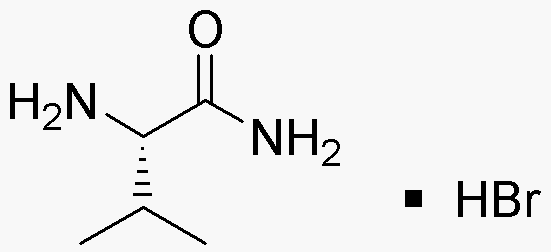L-Valine amide hydrobromide is widely utilized in research focused on:
- Biochemical Research: It serves as a building block in peptide synthesis, aiding researchers in developing new therapeutic peptides for various diseases.
- Pharmaceutical Development: This compound is used in drug formulation processes, particularly in creating amino acid derivatives that can enhance drug solubility and stability.
- Nutrition Science: It is explored in studies related to amino acid supplementation, helping to improve muscle recovery and performance in athletes.
- Neuroscience: Researchers investigate its role in neurotransmitter synthesis, contributing to the understanding of brain function and potential treatments for neurological disorders.
- Cosmetic Industry: The compound is incorporated into skincare formulations for its moisturizing properties, promoting skin health and hydration.
General Information
Properties
Safety and Regulations
Applications
L-Valine amide hydrobromide is widely utilized in research focused on:
- Biochemical Research: It serves as a building block in peptide synthesis, aiding researchers in developing new therapeutic peptides for various diseases.
- Pharmaceutical Development: This compound is used in drug formulation processes, particularly in creating amino acid derivatives that can enhance drug solubility and stability.
- Nutrition Science: It is explored in studies related to amino acid supplementation, helping to improve muscle recovery and performance in athletes.
- Neuroscience: Researchers investigate its role in neurotransmitter synthesis, contributing to the understanding of brain function and potential treatments for neurological disorders.
- Cosmetic Industry: The compound is incorporated into skincare formulations for its moisturizing properties, promoting skin health and hydration.
Documents
Safety Data Sheets (SDS)
The SDS provides comprehensive safety information on handling, storage, and disposal of the product.
Product Specification (PS)
The PS provides a comprehensive breakdown of the product’s properties, including chemical composition, physical state, purity, and storage requirements. It also details acceptable quality ranges and the product's intended applications.
Certificates of Analysis (COA)
Search for Certificates of Analysis (COA) by entering the products Lot Number. Lot and Batch Numbers can be found on a product’s label following the words ‘Lot’ or ‘Batch’.
*Catalog Number
*Lot Number
Certificates Of Origin (COO)
This COO confirms the country where the product was manufactured, and also details the materials and components used in it and whether it is derived from natural, synthetic, or other specific sources. This certificate may be required for customs, trade, and regulatory compliance.
*Catalog Number
*Lot Number
Safety Data Sheets (SDS)
The SDS provides comprehensive safety information on handling, storage, and disposal of the product.
DownloadProduct Specification (PS)
The PS provides a comprehensive breakdown of the product’s properties, including chemical composition, physical state, purity, and storage requirements. It also details acceptable quality ranges and the product's intended applications.
DownloadCertificates of Analysis (COA)
Search for Certificates of Analysis (COA) by entering the products Lot Number. Lot and Batch Numbers can be found on a product’s label following the words ‘Lot’ or ‘Batch’.
*Catalog Number
*Lot Number
Certificates Of Origin (COO)
This COO confirms the country where the product was manufactured, and also details the materials and components used in it and whether it is derived from natural, synthetic, or other specific sources. This certificate may be required for customs, trade, and regulatory compliance.


